
Drop the disposables: Diapers
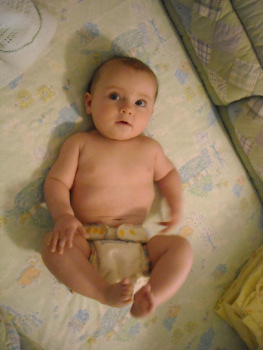 Tell folks you use cloth
diapers and immediately get looks of surprise,
horror and disgust. Yes, I use cloth, but these are not your
mother's
diapers. They're much more absorbent, especially for night-time
--- the
only leaks I've had have been from disposables. There's nothing
creepier in the morning than pulling off a diaper heavy with the
cellulose gel that disposables are filled with. Cloth diapers can
easily pay for themselves in a year or less, depending on the type you
use, and there are few things more gratifying than knowing you will
never run out.
Tell folks you use cloth
diapers and immediately get looks of surprise,
horror and disgust. Yes, I use cloth, but these are not your
mother's
diapers. They're much more absorbent, especially for night-time
--- the
only leaks I've had have been from disposables. There's nothing
creepier in the morning than pulling off a diaper heavy with the
cellulose gel that disposables are filled with. Cloth diapers can
easily pay for themselves in a year or less, depending on the type you
use, and there are few things more gratifying than knowing you will
never run out.
Types of diapers
New diaper options include fitteds, all-in-ones (AIO's) and much
better prefolds. Fitteds and AIO's feature elasticized legs and
waists
to hold in all the goodies that come out. They're especially
handy for
the more liquid poo of breastfed babies. They are usually made
from
cotton, hemp or bamboo fleece. 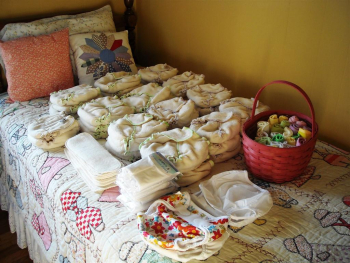 Hemp is by far the most
absorbent and
feels the least wet on baby's skin.
Hemp is by far the most
absorbent and
feels the least wet on baby's skin.
Fitteds require a cover, but even
these are better than they used to be. Most are made of PUL, a
waterproof nylon that has none of the leakage or crinkling of the
plastic pants of yesteryear. A good number of parents also enjoy
wool soakers,
which are extremely breathable and great fun for knitters. They
use
the power of lanolin to remain waterproof and require very few
washings.
AIO's don't need a cover because everything you need is in
one package. The outside is PUL with a micro-fiber inside to
block out
wetness. Simply add inserts to up absorbency based on the output
of
your child.
Modern prefolds are much better, too. Many are made of
Egyptian cotton and really soak up quite a bit. They have some of
the
leakage issues when it comes to blow outs, but many prefer their
simplicity and cost.
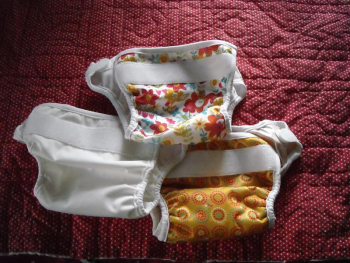 Are diapers expensive?
Are diapers expensive?
Speaking of cost--how much will all this set you back? For about
$700 or so, you can diaper your child from birth to potty
training.
This cost includes the diapers, covers and cloth wipes (which can be
made by anybody with a sewing machine).
Some diapers are sized and
some are one-size. One-size diapers usually cost more than those
that
are sized, but the cost difference is about the same either way.
Of
course, if you want to spend it, there are some gorgeous and very
pricey cloth diaper makers out there.
Prices start from $1 per prefold
to $13 per fitted to $18 for a AIO. One-size fitteds cost about
as
much as AIO's, but the trade off is a diaper that will fit the whole
time you need them to. Here's a cost breakdown calculator to see how long it will take
your diapers to pay for themselves.
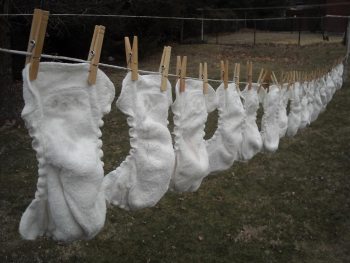 But I have to wash them!
But I have to wash them!
Laundry is old news to parents, so adding three extra loads a week
for diapers really isn't much. And how do we wash our
diapers? There
are several techniques, but here's what we do: dry pail dirty diapers,
cold wash with half detergent, hot wash with half detergent, cold
rinse. For good measure and extra cleaning power, you can add 1/2
cup
of white vinegar to your fabric softener holder.
Diapers can be
line-dried or machine-dried, but be aware that fitteds and some AIO's
can take much longer to dry because of their bulk. Sunning
diapers on
the line is great to kill any germs and yeast. An important note:
if
you purchase diapers from a used-diaper seller (where only pristine and
well-cared for diapers are accepted), you should wash them thoroughly
and sun them to avoid picking up a yeasty diaper rash. Tea tree
oil is
great to rid your diapers of anything icky, just be sure to rinse them
well since it's such a powerful essential oil.
Resources
There are infinitely many
resources for cloth diapering on the internet, but here are a few tips
and links to get you started:
- Avoid bleach for all diapers, except prefolds. Just like how it eats your clothes, bleach can eat your beloved cloth diaper investment. Vinegar, tea tree oil and the sun will take care of practically all stains and germs.
- Make sure the diaper is tucked into its cover all around--back, legs and front. If not, you'll get leaks for sure and yet another infant wardrobe change.
- Cloth diapers of most any kind will make for a bulkier baby behind. This means you'll likely need to get clothes a bit bigger than you would if you used disposables. Some baby pants may not fit, but Speesees makes a pant with extra room for people like us.
- Your baby will definitely feel wet with a cloth diaper on and
likely need changing a little more often. But really, who wants
to sit
on pee for several hours, anyway? For night time, you can make
simple
homemade fleece liners to help keep wetness away from
skin.
- Diapering with pre-folds at Tammy's Recipes.
- Crazy for Cloth at Mothering.
- Benefits of cloth diapers at Sunshine Diapers.
- The Real Diaper Association.
- Cotton Babies--where I've ordered most of my cloth diaper supplies.
- Diapering how-to at the Diaper Hyena.
- Sweet Little Blessings--I ordered my hemp Baby Beehinds here. Free shipping!
- Traditional diaper rash creams will waterproof your diapers, so here's a list of the most common creams and their compatibility with cloth.
- Cloth diapers are exceptionally cute and come in lots of fun prints, so be mindful of this addictive factor to keep your frugality in check.
style="font-family: Bitstream Charter;">
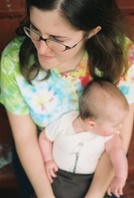
Brandy seeks self-sufficiency on a little lot in town, tending her most sincere pumpkin patch and borrowing the neighbor's clothesline. She lives with her husband Mike and daughter Willow, both of whom love it when she knits for them. Check out Brandy's blog and her etsy shop (full of hand-made napkins and other goodies to help you ditch the disposables.)
| This post is part of our Drop the Disposables lunchtime series.
Read all of the entries: |
Want more in-depth information? Browse through our books.
Or explore more posts by date or by subject.
About us: Anna Hess and Mark Hamilton spent over a decade living self-sufficiently in the mountains of Virginia before moving north to start over from scratch in the foothills of Ohio. They've experimented with permaculture, no-till gardening, trailersteading, home-based microbusinesses and much more, writing about their adventures in both blogs and books.
Want to be notified when new comments are posted on this page? Click on the RSS button after you add a comment to subscribe to the comment feed, or simply check the box beside "email replies to me" while writing your comment.
